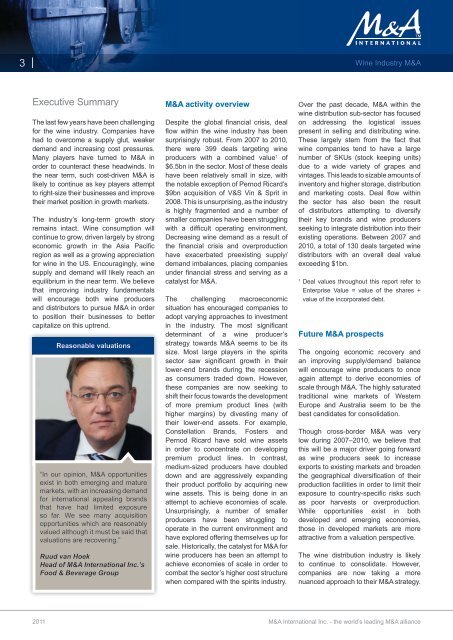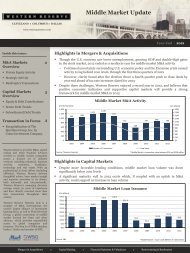Wine Industry Sector Report - Western Reserve Partners LLC
Wine Industry Sector Report - Western Reserve Partners LLC
Wine Industry Sector Report - Western Reserve Partners LLC
Create successful ePaper yourself
Turn your PDF publications into a flip-book with our unique Google optimized e-Paper software.
3<br />
<strong>Wine</strong> <strong>Industry</strong> M&A<br />
Executive Summary<br />
The last few years have been challenging<br />
for the wine industry. Companies have<br />
had to overcome a supply glut, weaker<br />
demand and increasing cost pressures.<br />
Many players have turned to M&A in<br />
order to counteract these headwinds. In<br />
the near term, such cost-driven M&A is<br />
likely to continue as key players attempt<br />
to right-size their businesses and improve<br />
their market position in growth markets.<br />
The industry’s long-term growth story<br />
remains intact. <strong>Wine</strong> consumption will<br />
continue to grow, driven largely by strong<br />
economic growth in the Asia Pacific<br />
region as well as a growing appreciation<br />
for wine in the US. Encouragingly, wine<br />
supply and demand will likely reach an<br />
equilibrium in the near term. We believe<br />
that improving industry fundamentals<br />
will encourage both wine producers<br />
and distributors to pursue M&A in order<br />
to position their businesses to better<br />
capitalize on this uptrend.<br />
Reasonable valuations<br />
“In our opinion, M&A opportunities<br />
exist in both emerging and mature<br />
markets, with an increasing demand<br />
for international appealing brands<br />
that have had limited exposure<br />
so far. We see many acquisition<br />
opportunities which are reasonably<br />
valued although it must be said that<br />
valuations are recovering.”<br />
Ruud van Hoek<br />
Head of M&A International Inc.’s<br />
Food & Beverage Group<br />
M&A activity overview<br />
Despite the global financial crisis, deal<br />
flow within the wine industry has been<br />
surprisingly robust. From 2007 to 2010,<br />
there were 399 deals targeting wine<br />
producers with a combined value 1 of<br />
$6.5bn in the sector. Most of these deals<br />
have been relatively small in size, with<br />
the notable exception of Pernod Ricard’s<br />
$9bn acquisition of V&S Vin & Sprit in<br />
2008. This is unsurprising, as the industry<br />
is highly fragmented and a number of<br />
smaller companies have been struggling<br />
with a difficult operating environment.<br />
Decreasing wine demand as a result of<br />
the financial crisis and overproduction<br />
have exacerbated preexisting supply/<br />
demand imbalances, placing companies<br />
under financial stress and serving as a<br />
catalyst for M&A.<br />
The challenging macroeconomic<br />
situation has encouraged companies to<br />
adopt varying approaches to investment<br />
in the industry. The most significant<br />
determinant of a wine producer’s<br />
strategy towards M&A seems to be its<br />
size. Most large players in the spirits<br />
sector saw significant growth in their<br />
lower-end brands during the recession<br />
as consumers traded down. However,<br />
these companies are now seeking to<br />
shift their focus towards the development<br />
of more premium product lines (with<br />
higher margins) by divesting many of<br />
their lower-end assets. For example,<br />
Constellation Brands, Fosters and<br />
Pernod Ricard have sold wine assets<br />
in order to concentrate on developing<br />
premium product lines. In contrast,<br />
medium-sized producers have doubled<br />
down and are aggressively expanding<br />
their product portfolio by acquiring new<br />
wine assets. This is being done in an<br />
attempt to achieve economies of scale.<br />
Unsurprisingly, a number of smaller<br />
producers have been struggling to<br />
operate in the current environment and<br />
have explored offering themselves up for<br />
sale. Historically, the catalyst for M&A for<br />
wine producers has been an attempt to<br />
achieve economies of scale in order to<br />
combat the sector’s higher cost structure<br />
when compared with the spirits industry.<br />
Over the past decade, M&A within the<br />
wine distribution sub-sector has focused<br />
on addressing the logistical issues<br />
present in selling and distributing wine.<br />
These largely stem from the fact that<br />
wine companies tend to have a large<br />
number of SKUs (stock keeping units)<br />
due to a wide variety of grapes and<br />
vintages. This leads to sizable amounts of<br />
inventory and higher storage, distribution<br />
and marketing costs. Deal flow within<br />
the sector has also been the result<br />
of distributors attempting to diversify<br />
their key brands and wine producers<br />
seeking to integrate distribution into their<br />
existing operations. Between 2007 and<br />
2010, a total of 130 deals targeted wine<br />
distributors with an overall deal value<br />
exceeding $1bn.<br />
1<br />
Deal values throughout this report refer to<br />
Enterprise Value = value of the shares +<br />
value of the incorporated debt.<br />
Future M&A prospects<br />
The ongoing economic recovery and<br />
an improving supply/demand balance<br />
will encourage wine producers to once<br />
again attempt to derive economies of<br />
scale through M&A. The highly saturated<br />
traditional wine markets of <strong>Western</strong><br />
Europe and Australia seem to be the<br />
best candidates for consolidation.<br />
Though cross-border M&A was very<br />
low during 2007–2010, we believe that<br />
this will be a major driver going forward<br />
as wine producers seek to increase<br />
exports to existing markets and broaden<br />
the geographical diversification of their<br />
production facilities in order to limit their<br />
exposure to country-specific risks such<br />
as poor harvests or overproduction.<br />
While opportunities exist in both<br />
developed and emerging economies,<br />
those in developed markets are more<br />
attractive from a valuation perspective.<br />
The wine distribution industry is likely<br />
to continue to consolidate. However,<br />
companies are now taking a more<br />
nuanced approach to their M&A strategy.<br />
2011<br />
M&A International Inc. - the world’s leading M&A alliance






